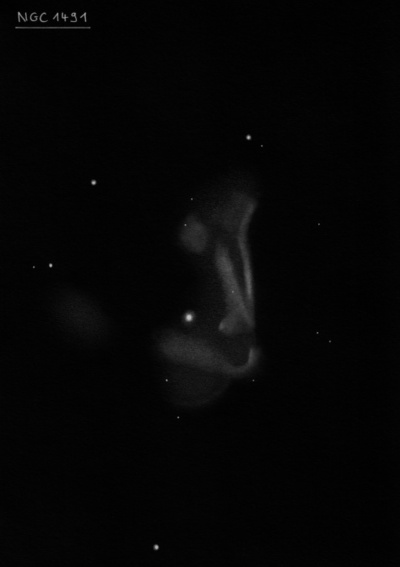
William Herschel discovered NGC 1491 = H I-258 on 28 Dec 1790 (sweep 989) and recorded "vB, iF, resolvable, bM, 5' l, 3 or 4' br. A pL star in it towards the following side, but unconnected." His position is fairly accurate, though Dreyer used a micrometric position of an involved star by Engelhardt. See Corwin's notes.
200/250mm - 8" (11/14/80): bright, large, ~6' diameter. A mag 10.5 star is at the east side.
300/350mm - 13.1" (1/18/85): bright emission nebula just west of a mag 10.5 star, extends SW-NE, interesting shape.
400/500mm - 17.5" (3/2/02): at 100x, this is a moderately bright, roundish glow, ~3' diameter. Extends mostly west of a mag 11 star, wrapping around the star, particularly on the north side. Excellent contrast gain with an OIII filter as it appears bright with an irregular surface brightness. There is a subtle bite cut out of the nebulosity on the east side that creates a darker hollow extending just west of the star. At 220x (unfiltered), about a half dozen stars are involved or at the edges. The nebulosity is quite irregular with a high surface brightness region preceding the star. Faint, elongated haze extends from this patch to the NE past the star giving an elongated appearance. A pair of mag 13-14 stars is at the northern end and another pair is just off the western edge.
17.5" (12/8/90): at 140x with OIII filter appears as a bright, moderately large, circular nebulosity involving a mag 11 star. The brightest portion lies to the west of the star and is elongated 3:2 ~N-S. There appears be a dark gap just west of the mag 11 star. Two very faint stars are superimposed near the edges.
Notes by Steve Gottlieb